1. Choose correct option
A. Sugar, amino acids and nucleotides unite to their respective subunits to form——–
a. bioelements
b. micromolecules
c. macromolecules
d. all of these
B. Glycosidic bond is found in —————.
a. Disaccharide
b. Nucleosides
c. Polysaccharide
d. all of theses
C. Amino acids in a polypeptide are joined by —————bond.
a. Disulphide
b. glycosidic
c. hydrogen bond
d. none of these
D. Lipids associated with cell membrane are ————.
a. Spingomyelin
b. Isoprenoids
c. Phospolipids
d. Cholesterol
E. Linoleic, Linolenic and ——————– acids are referred as essential fatty acids since they cannot be synthesized by the body and hence must be included in daily diet.
a. Arachidonic
b. Oleic
c. Steric
d. Palmitic
F. Haemoglobin is a type of ————– protein, which plays indispensible part in respiration.
a. simple
b. derived
c. conjugated
d. complex
G. When inorganic ions or metallo-organic molecules bind to apoenzyme, they together form——
a. isoenzyme
b. holoenzyme
c. denatured enzyme
d. none of these
H. In enzyme kinetics, Km= Vmax/2. If Km value is lower, it indicates —————-
a. Enzyme has less affinity for substrate
b. Enzyme has higher affinity towards substrate
c. There will be no product formation
d. All active sites of enzyme are saturatedb
2. Solve the following questions
A. Observe the following figure and name the type of bond shown by arrow in the structure.
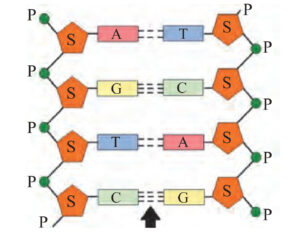
Ans : The type of bond shown in the diagram is hydrogen bond.
 (3) Answer the following questions
(3) Answer the following questions
(A) What are building blocks of life?
Ans: Life is composed of four main building blocks: Carbohydrates, proteins, lipids and nucleic acids.
(B) Explain the peptide bond.
Ans: (a) The covalent bond that links the two amino acids is called a peptide bond.
(b) Peptide bond is formed by condensation reaction.
(C) How many types of polysaccharides you know?
Ans: There arc two types of polysaccharides:
(a) Homopolysaccharides: It contains same type of monosaccharides. E.g. Starch, glycogen, cellulose.
(b) Hctcropolysaccharidcs: It contains two or more different monosaccharides. E.g. Hyaluronic acid, heparin, hemicellulose.
(D) Enlist the significance of carbohydrates.
Ans: Significances of carbohydrates are as follows:
(a) Carbohydrates provide energy for metabolism.
(b) Glucose is the main substrate for ATP synthesis.
(c) Lactose, a disaccharide present in the milk provides energy to babies.
(d) Polysaccharide serves as a structural component of cell membrane, cell wall and reserved food as starch and glycogen
(E) What is reducing sugar?
Ans : (a)A sugar that serves as a reducing agent due to presence of free aldehyde or ketone group is called a reducing sugar.
(b) These sugars reduce the Benedict’s reagent (Cu2- to Cu+) since they are capable of transferring hydrogens (electrons) to other compounds, a process called reduction.
(c) All monosaccharides arc reducing sugars.
(F) What is the basic difference between saturated and unsaturated fatty acid?
Ans :
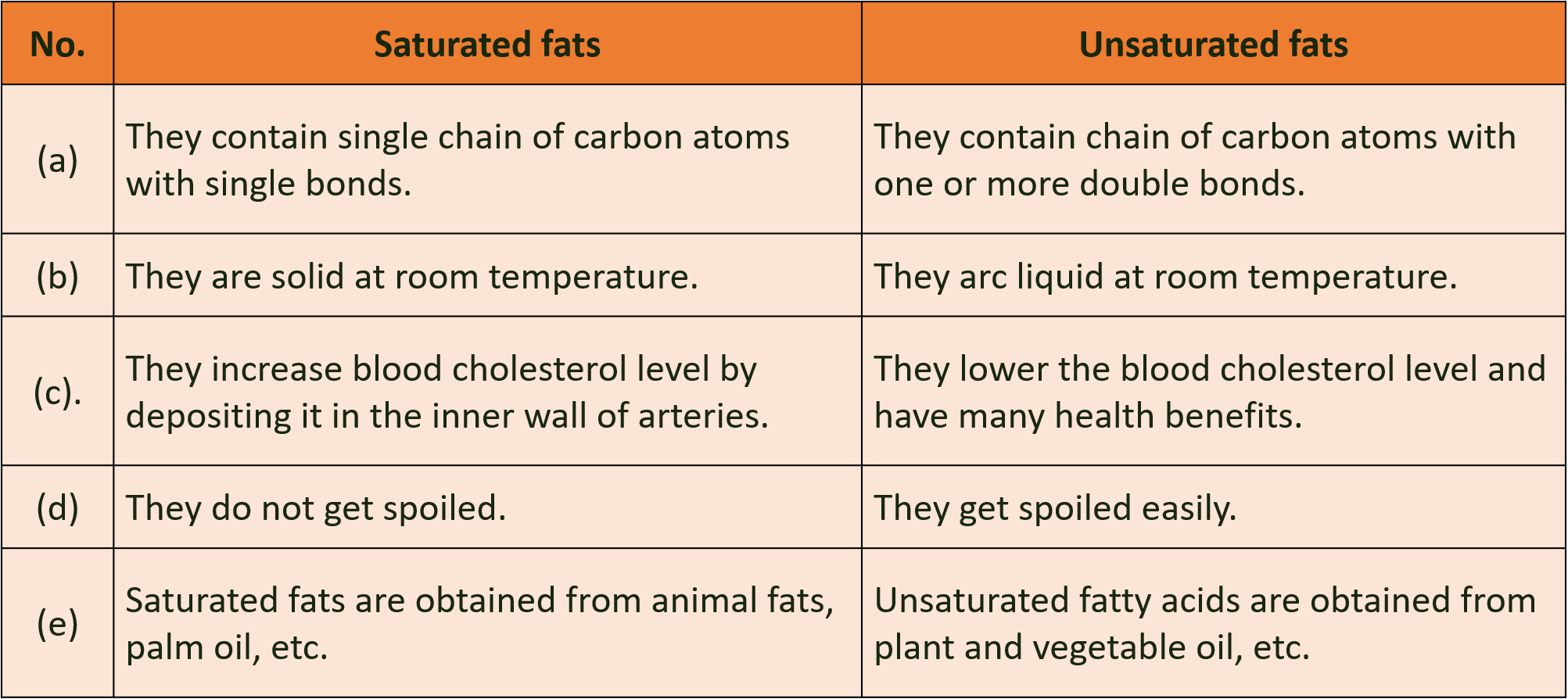
(G) Enlist the examples of simple proteins and give their significance.
Ans: Examples of simple proteins arc: E.g.: Albumins and histones.
Significance:
(i) Albumin:
(a) It is the main protein in the blood.
(b) It maintains the pressure in the blood vessels.
(c) It helps in transportation of substances like hormone and drugs in the body.
(ii) Histones:
(a) It is the chief protein of chromatin.
(b) They are involved in packaging of DNA into structural units called nucleosomes.
(H) Explain the secondary structure of protein with examples.
Ans :
(a) There are two types of secondary structure of protein: α-helix and β-pleated sheets.
(b) The polypeptide chain is arranged in a spiral helix. These spiral helices are of two types: α-helix (right handed) and β-helix (left handed).
(c) This spiral configuration is held together by hydrogen bonds.
(d) The sequence of amino acids in the polypeptide chain determines the location of its bend or fold and the position of formation of hydrogen bonds between different portions of the chain or between different chains. Thus, peptide chains form an a-helix structure.
(e) Example of a-helix structure is keratin.
(f) In some proteins two or more peptide chains are linked together by intermolecular hydrogen bonds. Such structures are called β-pleated sheets.
(g) Example of β-pleated sheet is silk fibres ].
(h) Due to formation of hydrogen bonds peptide chains assume a secondary structure.
(I) Explain the induced fit model for mode of enzyme action.
Ans: The induced fit model shows that enzymes are flexible structures in which the active site continually reshapes by its interactions with the substrate until the time the substrate is completely bound to it. It is also the point at which the final form and shape of the enzyme is determined.
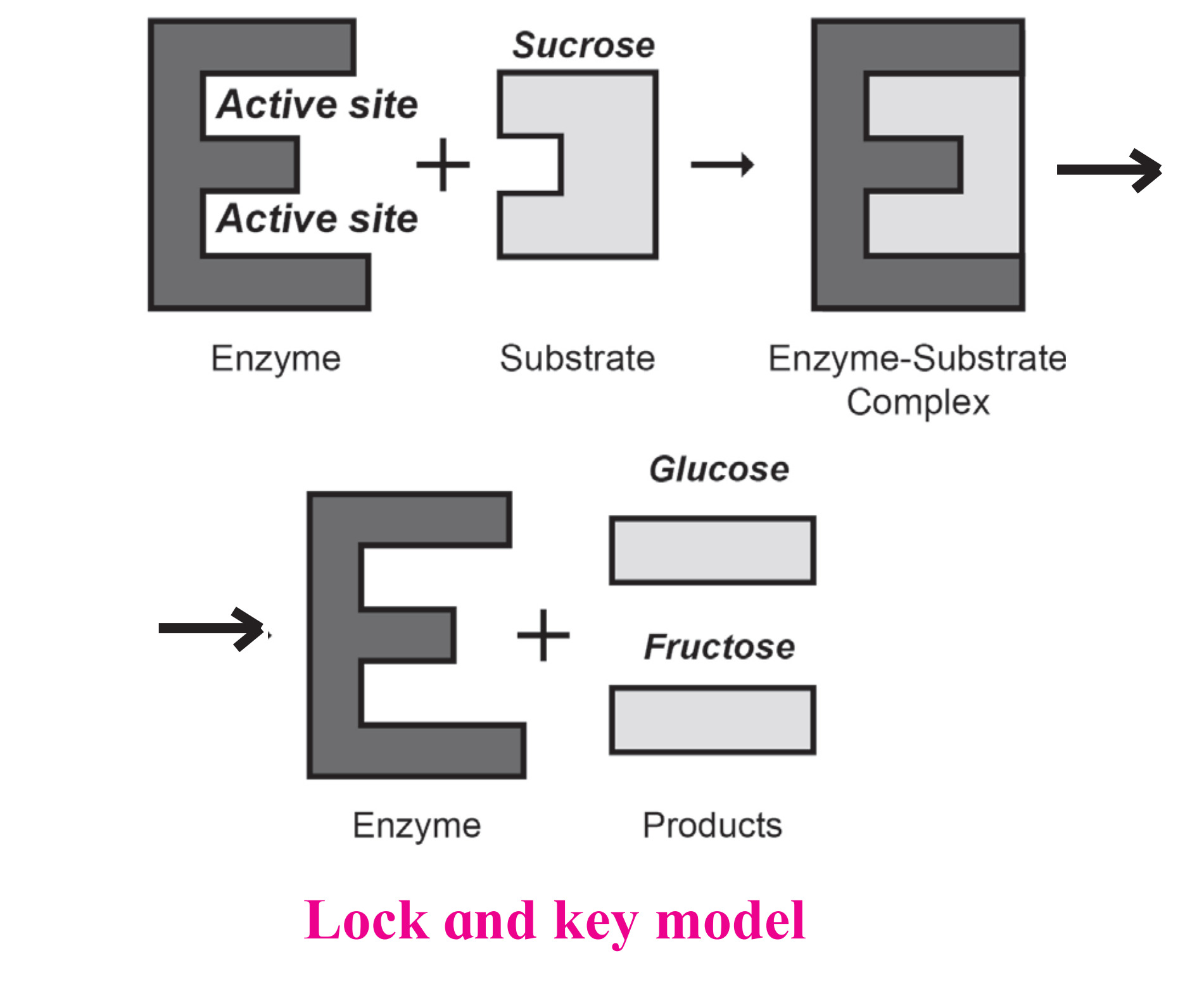
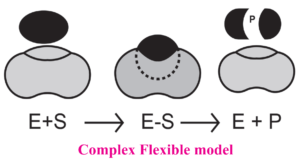
(J) What is RNA? Enlist types of RNA.
Ans: (a) RNA stands for Ribonucleic Acid. It is a long single stranded polynucleotide chain which helps in protein synthesis, functions as a messenger and translates messages coded in DNA into protein.
(b)There are three types of RNA:
mRNA (messenger RNA), rRNA (ribosomal RNA) and tRNA (transfer RNA)
(K) Describe the concept of metabolic pool.
Ans: (a) Metabolic pool is the reservoir of biomolecules in the cell on which enzymes can act to produce useful products as per the need of the cell.
(b) The concept of metabolic pool is significant in cell biology because it allows one type of molecule to change into another type E.g. Carbohydrates can be converted to fats and vice-versa.
(L) How do secondary metabolites useful for mankind?
Ans:
(a)Drugs developed from secondary metabolites have been used to treat infectious diseases, cancer, hypertension and inflammation.
(b)Morphine, the first alkaloid isolated from Papaver somniferum is used as pain reliver and cough suppressant.
(c)Secondary metabolites like alkaloids, nicotine, cocaine and the terpenes, cannabinol are widely used for recreation and stimulation.
(d)Flavours of secondary metabolites improve our food preferences.
(e) Tannins are added to wines and chocolate for improving astringency.
(f) Since most secondary metabolites have antibiotic property, they are also used as food preservatives.
(g) Glucosinolatcs is a secondary metabolite which is naturally present in cabbage imparts a characteristic flavour and aroma because of nitrogen and sulphur-containing chemicals. It also offers protection to these plants from many pests.
4. Solve the following questions
A. Complete the following chart.
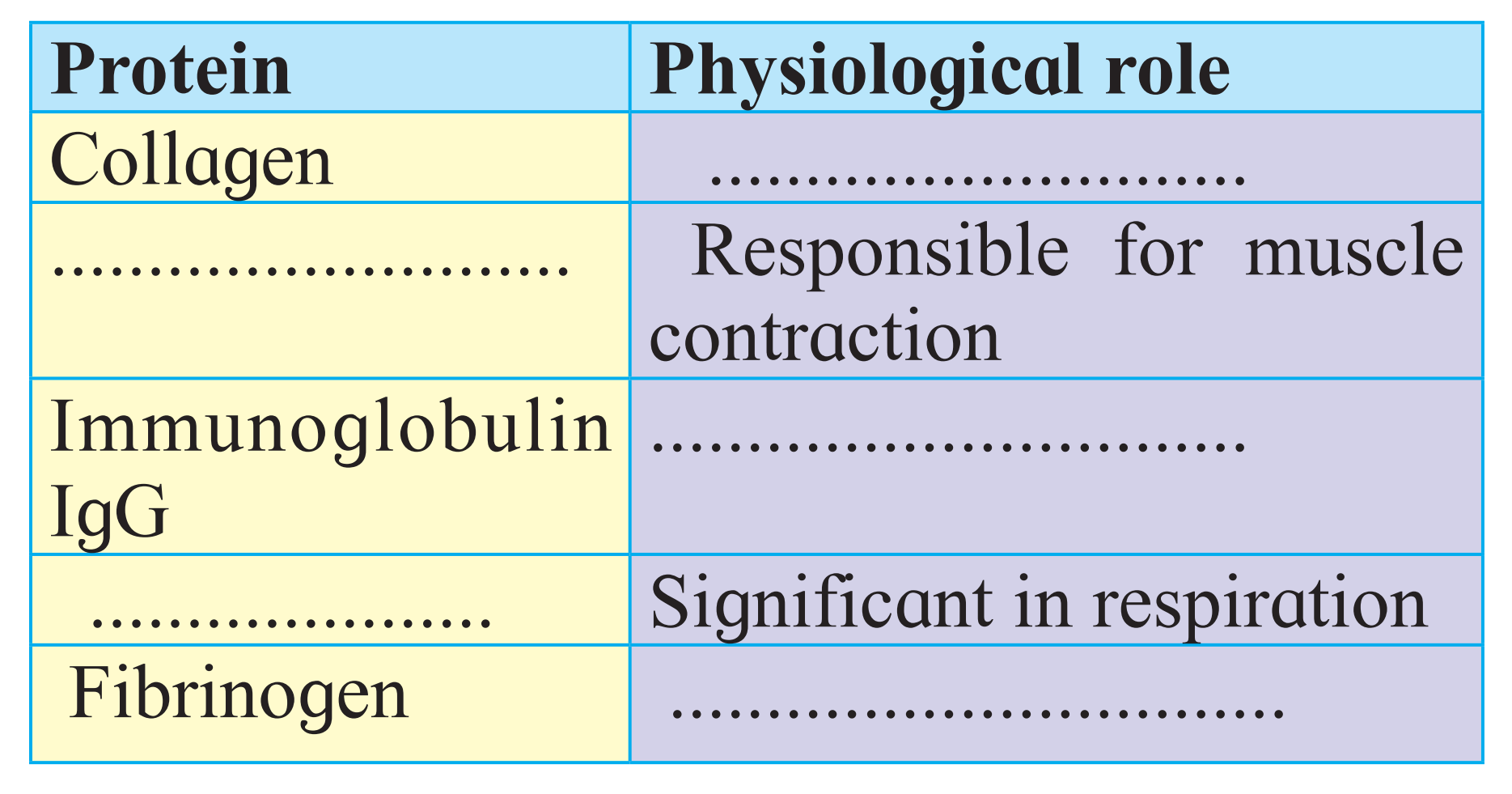
Ans :
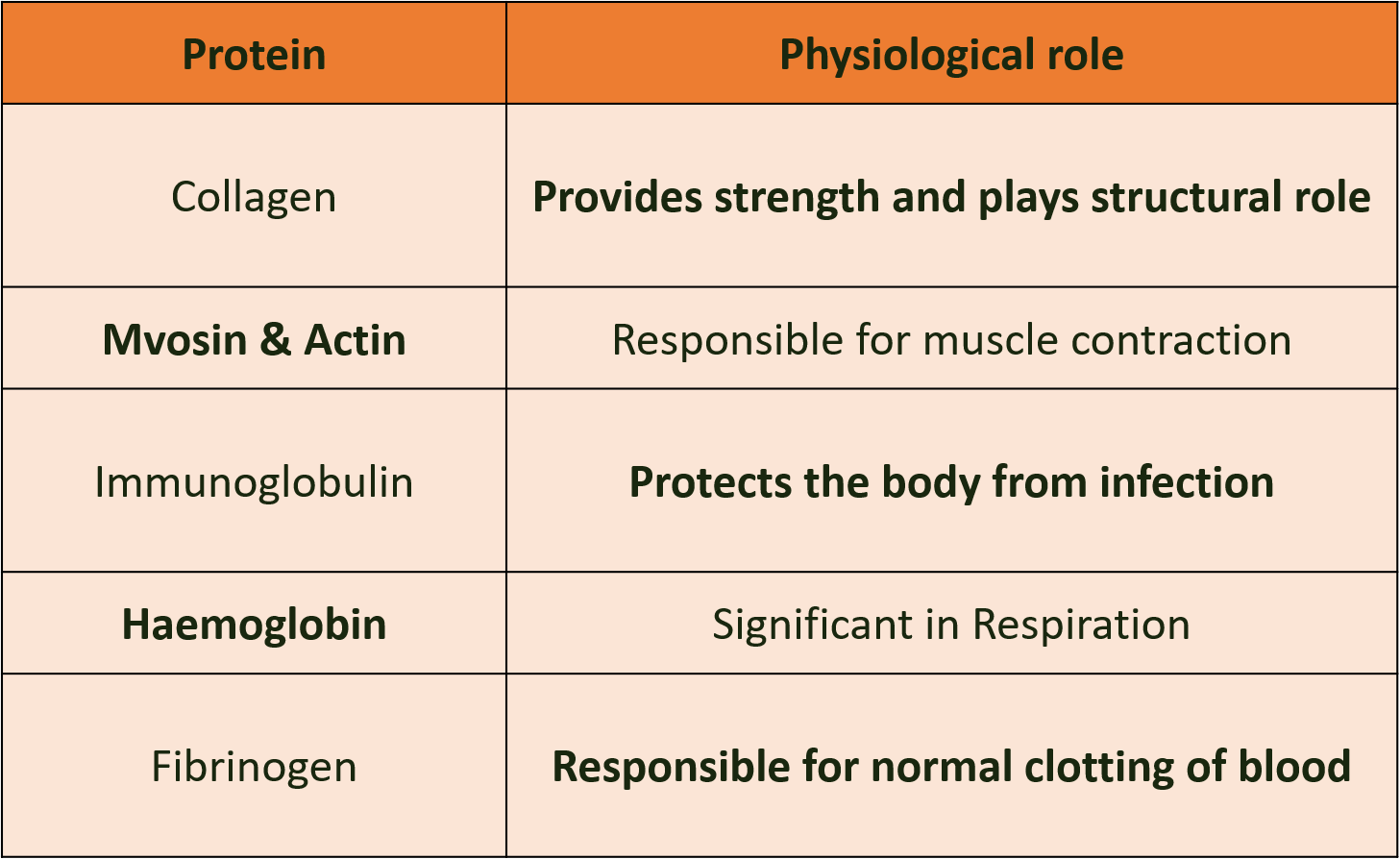
(B) Answer the questions with reference to the following figure.
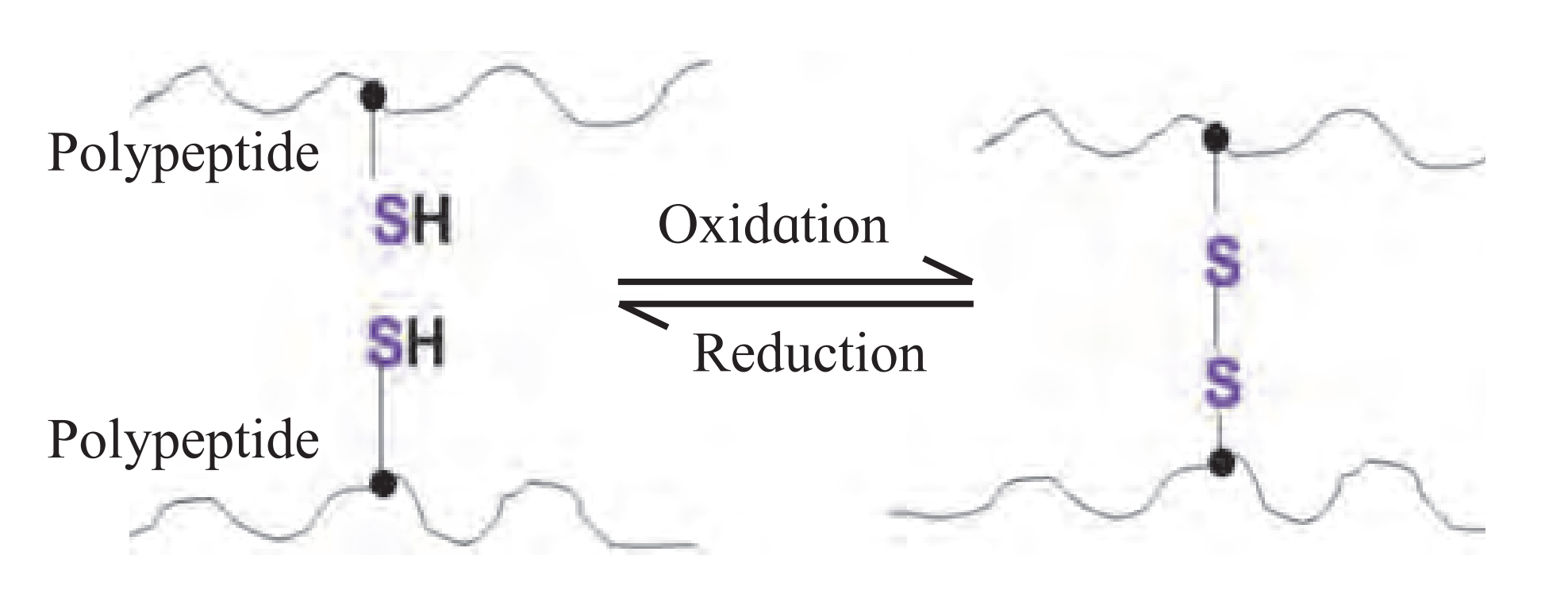
(a) Name the type of bond formed between two polypeptides.
(b) Which amino acid is involved in the fo rmation of such bond?
(c) Amongst I, II, III and IV structural level of protein, which level of structure includes such bond?
Ans:
(a) Disulfide bond. (b)Cysteine (d) Tertiary structure.
(C) Match the following items given in column I and II
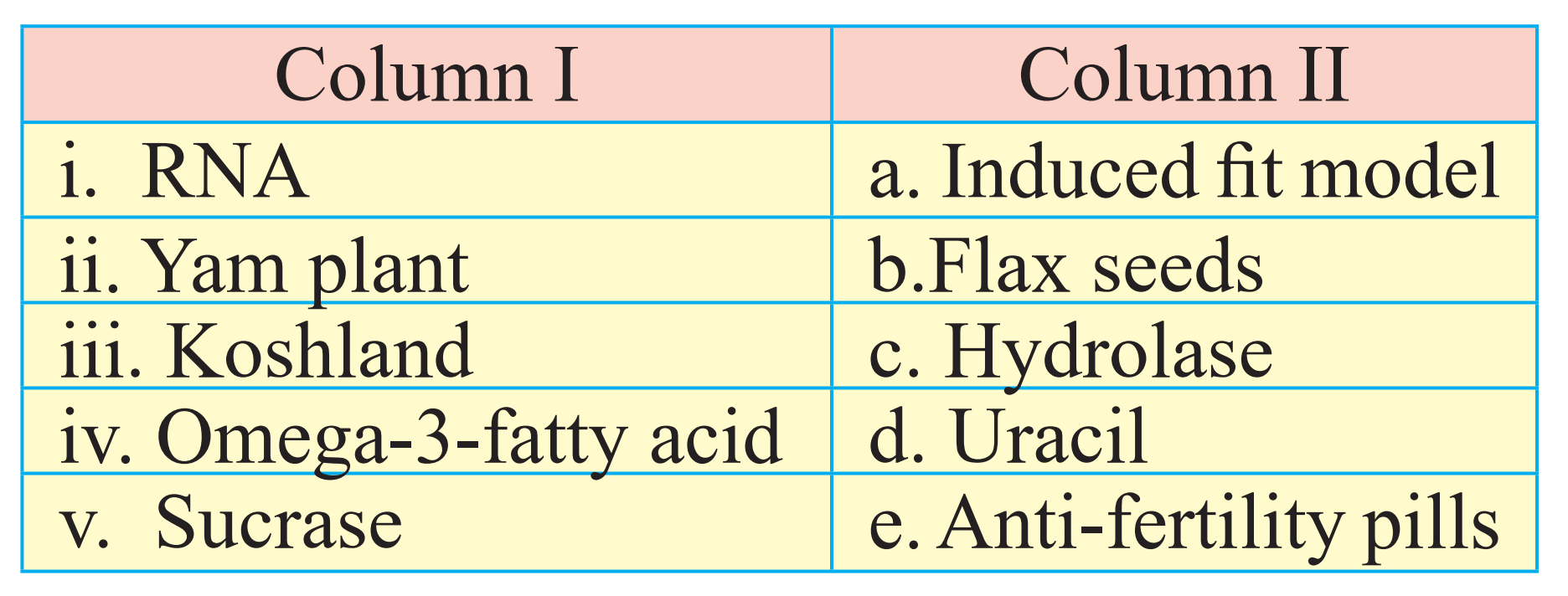
Ans: (i – d), (ii – c), (iii – a), (iv – b), (v – c)
(5) Long answer questions
(A) What are biomolecules? Explain the building blocks of life.
Ans: Biomolccules are essential substances produced by our body which are necessary for life. The building blocks of life are carbohydrates, lipids, proteins and nucleic acids.
(i) Carbohydrates:
(a) Carbohydrates are biomolecules made from carbon, hydrogen and oxygen.
(b) The general formula of carbohydrates is (CH20 ) n.
(c) They contain hydrogen and oxygen in the same ratio as in water (2:1).
(d) Carbohydrates can be broken down to release energy.
(c) Based on sugar units, carbohydrates arc classified into three types: Monosaccharides, disaccharides and polysaccharides.
(ii) Lipids:
(a) These are group of substances with greasy consistency with long hydrocarbon chain containing carbon, hydrogen and oxygen.
(b) In lipids hydrogen to oxygen ration is greater than 2:1.
(c) Lipid is a broader term used for fatty acids and their derivatives.
(d) They are soluble in organic solvents (non-polar solvents).
(c) Fatty acids arc organic acids which are composed of hydrocarbon chain ending in carboxyl group (COOH).
(f) These are divided into: Saturated fatty acids and unsaturated fatty acids.
(g) Fatty acids are basic molecules which form different kinds of lipids.
(h) Lipids are classified into three types: Simple lipids, Compound lipids, Derived lipids.
(iii) Proteins:
(a) Proteins arc large molecules containing amino acid units ranging from 100 to 3000.
(b) They have higher molecular weight.
(c) In proteins, amino acids arc linked together by peptide bonds which join the carboxyl group of one amino acid residue to the amino group of another residue.
(d) A protein molecule consists of one or more polypeptide chains.
(e) Proteins contain any or all twenty naturally occurring amino acid types.
(f) Proteins have different structures like primary structure, secondary structure, tertiary structure and quaternary structure.
(g) Proteins are classified into three types: Simple proteins: Simple proteins on hydrolysis yield only amino acids. E.g. Histones and albumins.
Conjugated proteins: It consists of a simple protein united with some non-protein substance. E.g. Haemoglobin.
Derived proteins: These proteins arc not found in nature as such but arc derived from native protein molecules on hydrolysis. E.g. Metaproteins, peptones.
(iv) Nucleic Acids:
(a) Nucleic acids arc macromolccules composed of many small units or monomers called nucleotides.
(b) Each nucleotide is formed of three components i.e. pentose sugar, a nitrogen base and a phosphate (phosphoric acid).
(c) When sugar combine with nitrogenous base it forms nucleoside. Nucleotides can be called as nucleoside phosphate.
(d) There are two types of nucleic acids, i.e. DNA and RNA. DNA (Deoxyribonucleic acid) is a genetic material of a cell. It is double stranded helix. Each strand of helix is made up of deoxyribose nucleotides. RNA (Ribonucleic Acid) is a single stranded structure having fewer nucleotides as compared to DNA. The strands may be straight or variously folded upon itself. It is made up of nucleotides.
(B) Explain the classes of carbohydrates with examples.
Ans: Based on number of sugar units, carbohydrates are classified into three types namely, monosaccharides, disaccharides and polysaccharides.
(i) Monosaccharides:
(a) Monosaccharides are the simplest sugars having crystalline structure, sweet taste and soluble in water.
(b) They cannot be further hydrolyzed into smaller molecules.
(c) They are the building blocks or monomers of complex carbohydrates.
(d) They have the general molecular formula (CH20)n, where n can be 3, 4, 5, 6 and 7.
(e) They can be classified as triose, tetrose, pentose, etc.
(f) Monosaccharides containing the aldehyde (-CHO) group are classified as aldoses e.g. glucose, xylose, and those with a ketone(-C=0) group are classified as ketoses. E.g. ribulose, fructose.
(ii) Disaccharides:
(a) Disaccharidc is formed when two monosaccharide react by condensation reaction releasing a water molecule. This process requires energy.
(b) A glycosidic bond forms and holds the two monosaccharide units together.
(c) Sucrose, lactose and maltose are examples of disaccharides.
(d) Sucrose is a nonreducing sugar since it lacks free aldehyde or ketone group.
(e) Lactose and maltose are reducing sugars.
(f) Lactose also exists in beta form, which is made from β-galactose and β-glucose.
(g) Disaccharides are soluble in water, but they are too big to pass through the cell membrane by diffusion.
(iii). Polysaccharides:
(a) Monosaccharides can undergo a series of condensation reactions, adding one unit after the other to the chain till a very large molecule (polysaccharide) is formed. This is called polymerization.
(b) Polysaccharides are broken down by hydrolysis into monosaccharides.
(c) The properties of a polysaccharide molecule depends on its length, branching, folding and coiling.
(d) Examples: Starch, glycogen, cellulose.
(C) Describe the types of lipids and mention their biological significance.
Ans : Lipids are classified into three main types:
(i) Simple lipids:
(a) These arc esters of fatty acids with various alcohols. Fats and waxes arc simple lipids.
(b) Fats are esters of fatty acids with glycerol (CH2OH-CHOH-CH2OH).
(c) Triglycerides are three molecules of fatty acids and one molecule of glycerol.
(d) Unsaturated fats are liquid at room temperature and are called oils. Unsaturated fatty acids are hydrogenated to produce fats e.g. Vanaspati ghee.
Biological significance:
(a) Fats arc a nutritional source with high calorific value and they act as reserved food materials.
(b) In plants, fat is stored in seeds to nourish embryo during germination.
(c) In animals, fat is stored in the adipocytes of the adipose tissue.
(d) Fats deposited in subcutaneous tissue act as an insulator and minimize loss of body heat.
(e) Fats deposited around the internal organs act as cushions to absorb mechanical shocks.
(f) Wax is another example of simple lipid. They arc esters of long chain fatty acids with long chain alcohols.
(g) They are found in the blood, gonads and sebaceous glands of the skin.
(h) Waxes arc not as readily hydrolyzed as fats.
(i) They are solid at ordinary temperature.
(j) Waxes form water insoluble coating on hair and skin in animals, waxes form an outer coating on stems, leaves and fruits.
(ii) Compound lipids:
(a) These are ester of fatty acids containing other groups like phosphate (Phospholipids), sugar (glycolipids), etc.
(b) They contain a molecule of glycerol, two molecules of fatty acids and a phosphate group or simple sugar.
(c) Some phospholipids such as lecithin also have a nitrogenous compound attached to the phosphate group.
(d) Phospholipids have both hydrophilic polar groups (phosphate and nitrogenous group) and hydrophobic non-polar groups (hydrocarbon chains of fatty acids).
(e) Glycolipids contain glycerol, fatty acids, simple sugars such as galactose. They arc also called cerebrosides.
Biological significance:
(a) Phospholipids contribute in the formation of cell membrane.
(b) Large amounts of glycolipids arc found in the brain white matter and myelin sheath.
(iii) Derived Lipids:
(a) They are composed of fused hydrocarbon rings (steroid nucleus) and a long hydrocarbon side chain.
(b) One of the most common sterols is cholesterol.
Biological significance:
(a) It is widely distributed in all cells of the animal body, but particularly in nervous tissue.
(b) Cholesterol exists cither free or as cholesterol ester.
(c) Adrenocorticoids, sex hormones (progesterone, testosterone) and vitamin D are synthesized from cholesterol.
(d) Cholesterol is not found in plants.
(e) Sterols exist as phytosterols in plants.
(f) Yam Plant (Dioscorea) produces a steroid compound called diosgenin. It is used in the manufacture of antifertility pills, i.e. birth control pills.
(D) Explain the chemical nature, structure and role of phospholipids in biological membrane.
Ans: Chemical nature: Phospholipids are amphiphilic in nature. As they have hydrophilic head and hydrophobic tail.
Structure: It contains an alcohol, two fatty acid chains and a phosphate group.
Role: Phospholipids forms the membranes around the cells and cellular organelles. They form a lipid bilayer membrane. The phospholipids are arranged tail to tail. It serves as a barrier against movement of any ions or polar compounds into and out of the cell.
(E) Describe classes of proteins with their importance.
Ans :
On the basis of structure, proteins are classified into three categories:
(i)Simple proteins:
(a) Simple proteins on hydrolysis yield only amino acids.
(b) These are soluble in one or more solvents.
(c) Simple proteins may be soluble in water.
(d) Histones of nucleoproteins arc soluble in water.
(e) Globular molecules of histones are not coagulated by heat.
(f) Albumins are also soluble in water but they get coagulated on heating.
(g) Albumins are widely distributed e.g. egg albumin, serum albumin and legumelin of pulses are albumins.
Importance: They are involved in structural components; they also act as a storage kind of protein.
Some are associated with nucleic acids in nucleoproteins of cell.
(ii) Conjugated proteins:
(a) Conjugated proteins consist of a simple protein united with some non-protein substance.
(b) The non-protein group is called prosthetic group e.g. haemoglobin.
(c) Globin is the protein and the iron containing pigment haem is the prosthetic group.
(d) Similarly, nucleoproteins have nucleic acids.
(e) Proteins are classified as glycoproteins and mucoproteins.
(f) Mucoproteins are carbohydrate-protein complexes e.g. mucin of saliva and heparin of blood.
(g) Lipoproteins are lipid-protein complexes e.g. conjugate protein found in brain, plasma membrane, milk etc.
Importance: They arc involved in structural components of cell membranes and organelles.
They also act as a transporter.
Some conjugated proteins are important in electron transport chain in respiration.
(iii) Derived proteins:
(a) These proteins are not found in nature as such.
(b) These proteins are derived from native protein molecules on hydrolysis.
(c) Metaproteins, peptones are derived proteins.
Importance: They act as a precursor for many molecules which are essential for life.
(F) What are enzymes? How are they classified? Mention example of each class.
Ans :
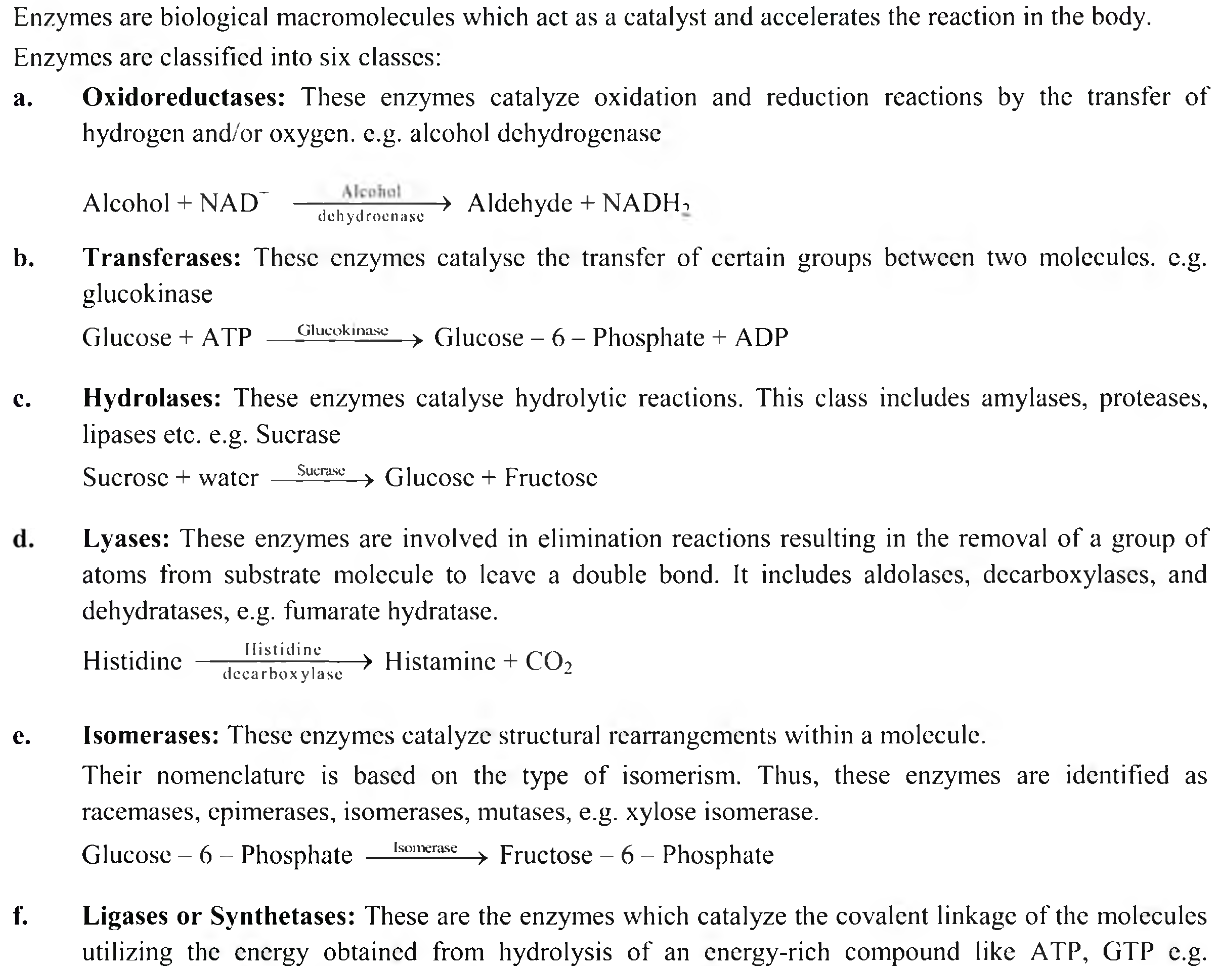
(G) Explain the properties of enzyme? Describe the models for enzyme actions.
Ans : (i) Proteinaceous Nature:
All enzymes are basically made up of protein.
(ii) Three-Dimensional conformation:
(a) All enzymes have specific 3-dimensional conformation.
(b) They have one or more active sites to which substrate (reactant) combines.
(c) The points of active site where the substrate joins with the enzyme is called substrate binding site.
(iii)Catalytic property:
(a) Enzymes are like inorganic catalysts and influence the speed of biochemical reactions but themselves remain unchanged.
(b) After completion of the reaction and release of the product they remain active to catalyze again.
(c) A small quantity of enzymes can catalyze the transformation of a very large quantity of the substrate into an end product.
(d) For example, sucrase can hydrolyze 100000 times of sucrose as compared with its own weight.
(iv) Specificity of action:
(a) The ability of an enzyme to catalyze one specific reaction and essentially no other is perhaps its most significant property. Each enzyme acts upon a specific substrate or a specific group of substrates.
(b) Enzymes are very sensitive to temperature and pH.
(c) Each enzyme exhibits its highest activity at a specific pH i.e. optimum pH.
(d) Any increase or decrease in pH causes decline in enzyme activity e.g. enzyme pepsin (secreted in stomach) shows highest activity at an optimum pH of 2 (acidic).
(e) Trypsin (in duodenum) is most active at an optimum pH of 9.5 (alkaline).
(f) Both these enzymes viz. pepsin and trypsin are protein digesting enzymes.
(v) Temperature:
(a) Enzymes are destroyed at higher temperature of 60-70°C or below, they are not destroyed but become inactive.
(b) This inactive state is temporary and the enzyme can become active at suitable temperature.
(c) Most of the enzymes work at an optimum temperature between 20°C and 35°C.
There are two types of models:
(i) Lock and Key model:
(a) Lock and Key model was first postulated in 1894 by Emil Fischer.
(b) This model explains the specific action of an enzyme with a single substrate.
(c) In this model, lock is the enzyme and key is the substrate.
(d) The correctly sized key (substrate) fits into the key hole (active site) of the lock (enzyme).

(ii) Induced Fit model (Flexible Model):
(a) Induced Fit model was first proposed in 1959 by Koshland.
(b) This model states that approach of a substrate induces a conformational change in the enzyme.
(c) It is the more accepted model to understand mode of action of enzyme.
(d) The induced fit model shows that enzymes are rather flexible structures in which the active site continually reshapes by its interactions with the substrate until the time the substrate is completely bound to it.
(c) It is also the point at which the final form and shape of the enzyme is determined
(H) Describe the factors affecting enzyme action.
Ans: The factors affecting the enzyme activity are as follows:
(i) Concentration of substrate:
(a) Increase in the substrate concentration gradually increases the velocity of enzyme activity within the limited range of substrate levels.
(b) A rectangular hyperbola is obtained when velocity is plotted against the substrate concentration.
(c) Three distinct phases (A, B and C) of the reaction are observed in the graph.
Where V = Measured velocity, Vmax = Maximum
velocity, S = Substrate concentration,
Km = Michaelis-Menten constant.
(d) Km or the Michaelis-Menten constant is defined as the substrate concentration (expressed in moles/lit) to produce half of maximum velocity in an enzyme catalyzed reaction.
(e) It indicates that half of the enzyme molecules (i.e. 50%) are bound with the substrate molecules when the substrate concentration equals the Km value.
(f) Km value is a constant and a characteristic feature of a given enzyme.
(g) It is a representative for measuring the strength of ES complex.
(h) A low Km value indicates a strong affinity between enzyme and substrate, whereas a high Km value reflects a weak affinity between them.
(i) For majority of enzymes, the Km values are in the range of 10-5 to 10-2 moles.
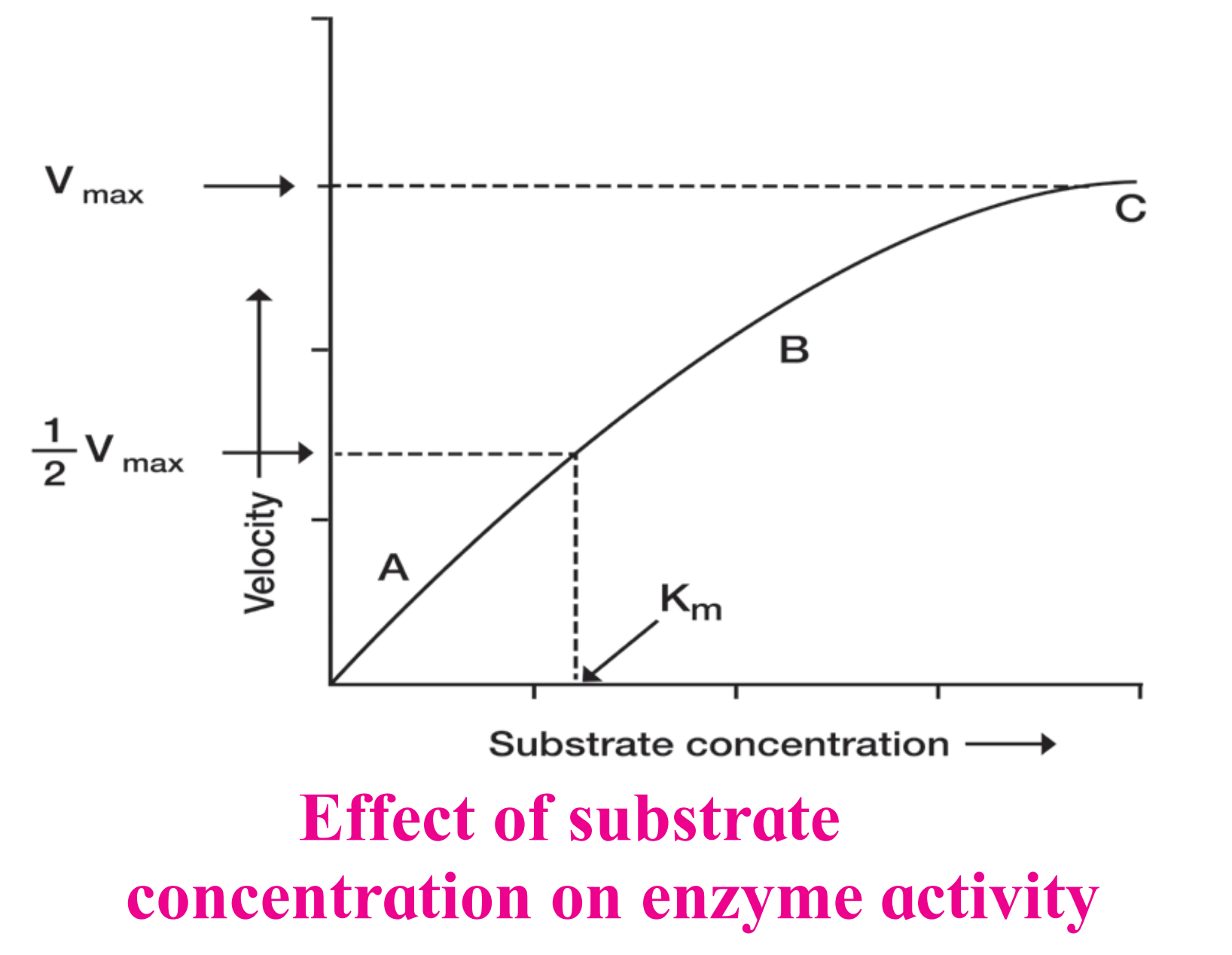
(ii) Enzyme Concentration:
(a) The rate of an enzymatic reaction is directly proportional to the concentration of the substrate.
(b) The rate of reaction is also directly proportional to the square root of the concentration of enzymes.
(c) It means that the rate of reaction also increases with the increasing concentration of enzyme and the rate of reaction can also decrease by decreasing the concentration of enzyme.
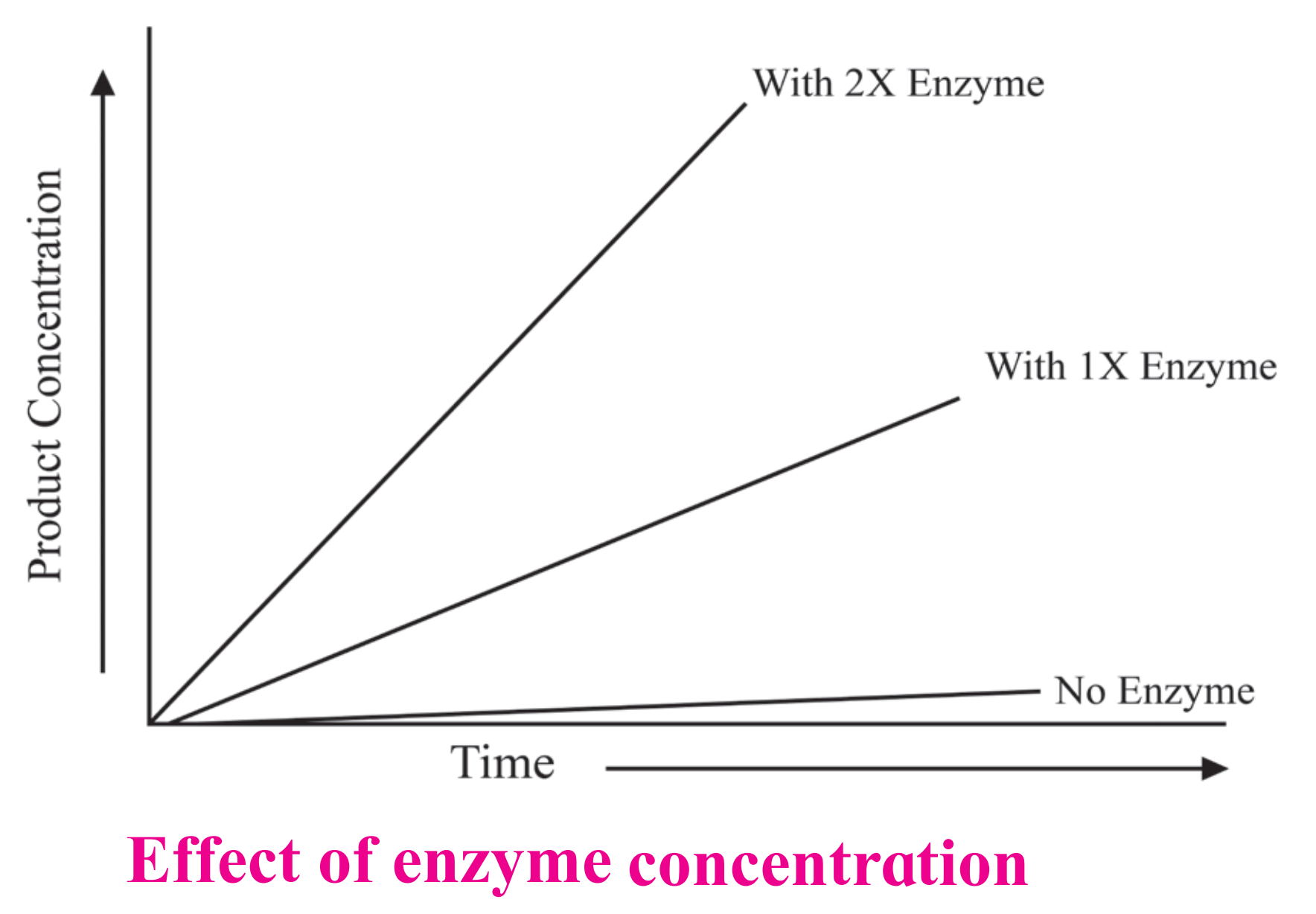
(iii) Temperature:
(a) The temperature at which the enzymes show maximum activity is called Optimum temperature.
(b) The rate of chemical reaction is increased by a rise in temperature but this is true only over a limited range of temperature.
(c) Enzymes rapidly denature at temperature above 40°C.
(d) The activity of enzymes is reduced at low temperature.
(e) The enzymatic reaction occurs best at or around 37°C which is the average normal body temperature in homeotherms.
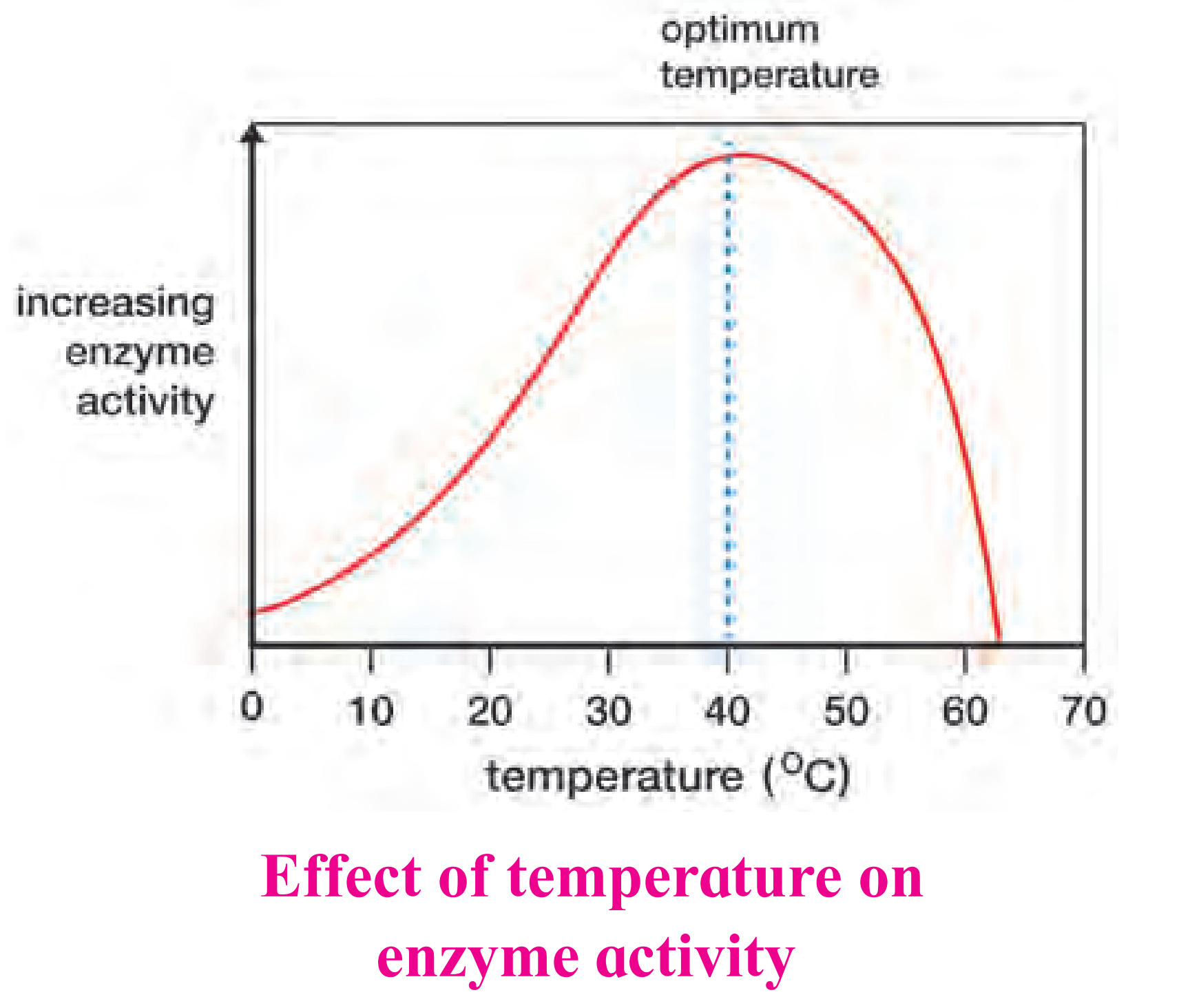
(iv) Effect of pH:
(a) The pH at which an enzyme catalyzes the reaction at the maximum rate is known as optimum pH.
(b) The enzyme cannot perform its function beyond the range of its pH value.
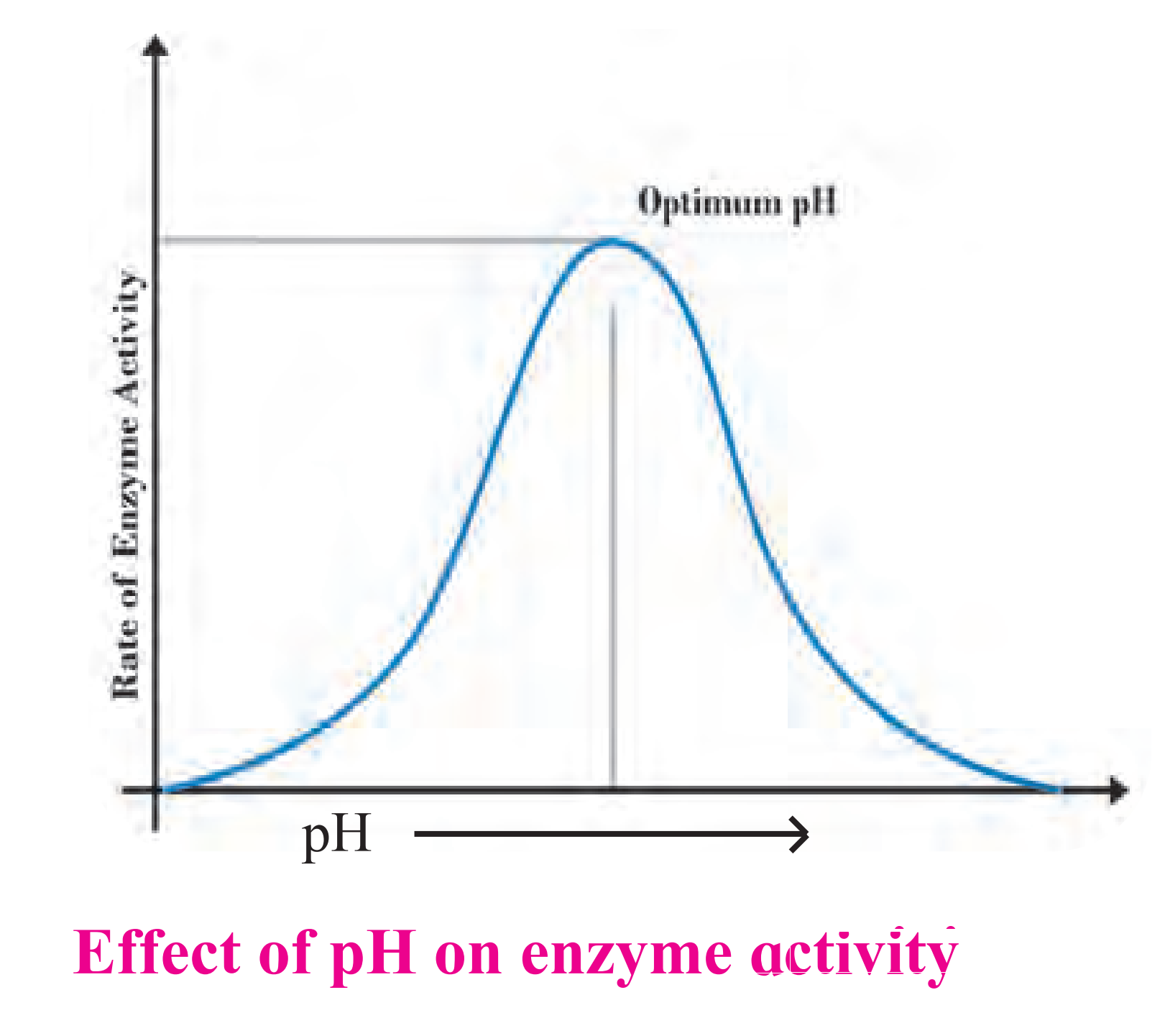
(v) Other substances:
(a) The enzyme action is also increased or decreased in the presence of some other substances such as coenzymes, activators and inhibitors.
(b) Most of the enzymes are combination of a co-enzyme and an apo-enzyme.
(c) Activators are the inorganic substances which increase the enzyme activity.
(d) Inhibitor is the substance which reduces the enzyme activity.
(I) What are nucleic acids? Enlist the point of differences among DNA and RNA.
Ans :
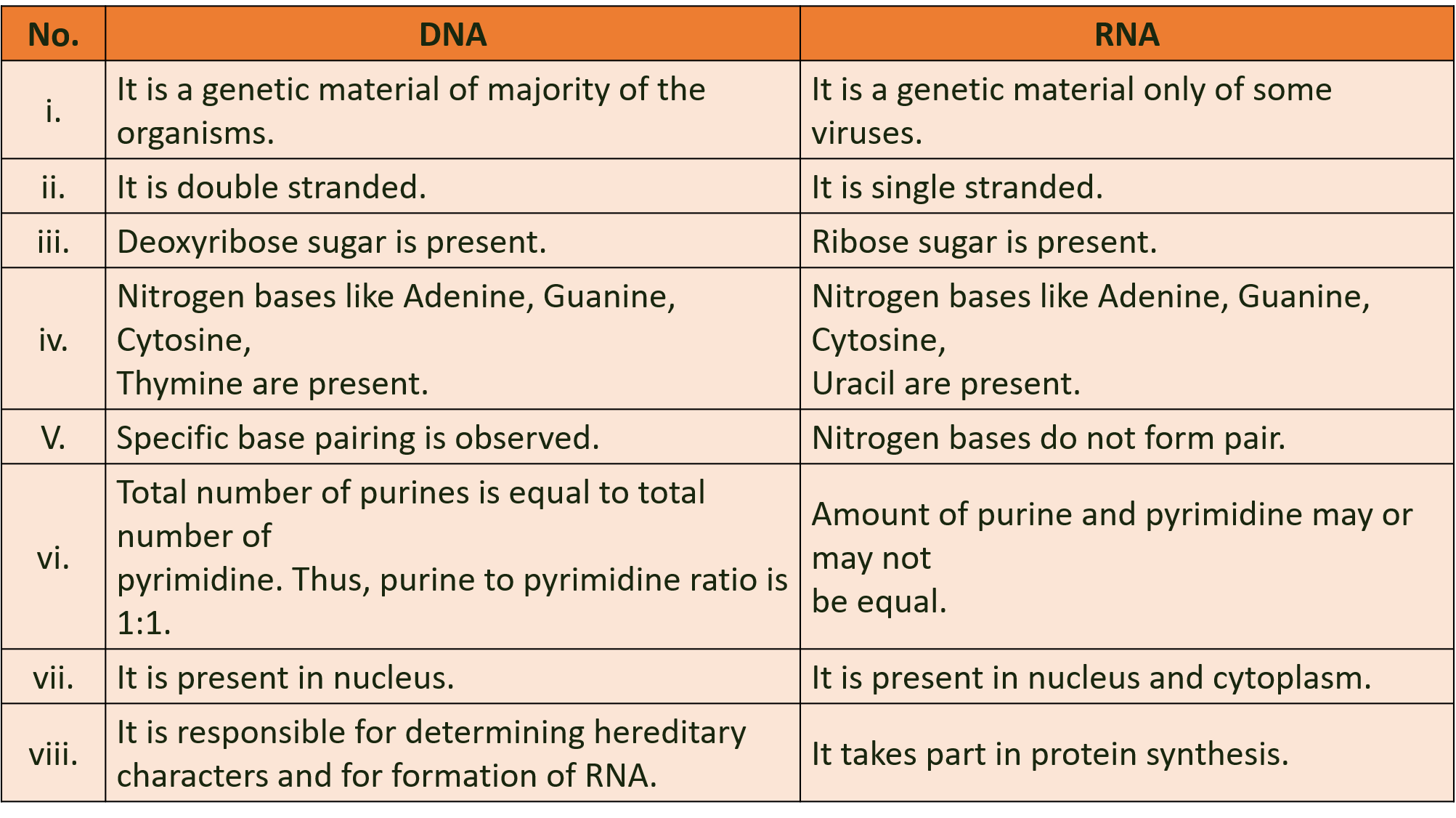
(J) What are the types of RNA? Mention the role of each class of RNA.
Ans: There arc three types of cellular RNAs: (i) messenger RNA (mRNA), (ii) ribosomal RNA (rRNA), (iii) transfer RNA (tRNA).
(i) Messenger RNA (mRNA):
(a) It is a linear polynucleotide.
(b) It accounts 3% of cellular RNA.
(c) Its molecular weight is several million.
(d) mRNA molecule carrying information to form a complete polypeptide chain is called cistron.
(c) Size of mRNA is related to the size of message it contains.
(f) Synthesis of mRNA begins at 5’ end of DNA strand and terminates at 3’ end.
Role of messenger RNA: It carries genetic information from DNA to ribosomes, which are the sites of protein synthesis.

(ii) Ribosomal RNA (rRNA):
(a) rRNA was discovered by Kurland in 1960.
(b) It forms 50-60% part of ribosomes.
(c) It accounts 80-90% of the cellular RNA.
(d) It is synthesized in nucleus.
(e) It gets coiled at various places due to intrachain complementary base pairing.
Role of ribosomal RNA: It provides proper binding site for m-RNA during protein synthesis.
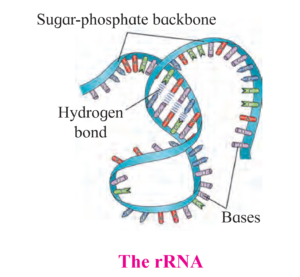
(iii) Transfer RNA (tRNA):
(a) These molecules are much smaller consisting of 70-80 nucleotides.
(b) Due to presence of complementary base pairing at various places, it is shaped like clover-leaf.
(c) Each tRNA can pick up particular amino acid.
(d) Following four parts can be recognized on tRNA
(1) DHU arm (Dihydroxyuracil loop/ amino acid recognition site
(2) Amino acid binding site
(3) Anticodon loop / codon recognition site
(4) Ribosome recognition site.
(e) In the anticodon loop of tRNA, three unpaired nucleotides are present called as anticodon which pair with codon present on mRNA.
(f) The specific amino acids are attached at the 3’ end in acceptor stem of clover leaf of tRNA.
Role of transfer RNA: It helps in elongation of polypeptide chain during the process called translation.
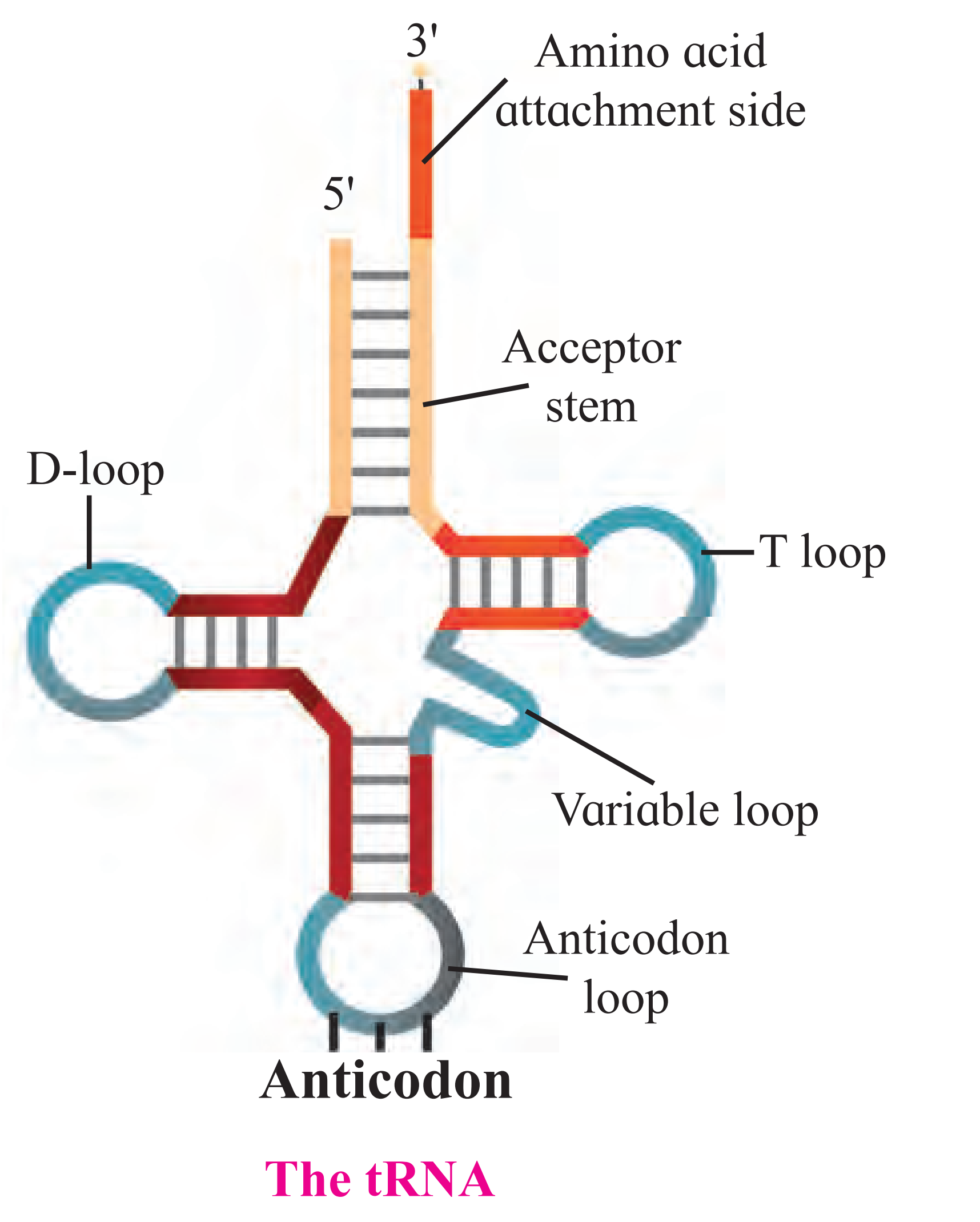
(K) What is metabolism? How metabolic pool is formed in the cell.
Ans:
(a) Metabolism is the sum of the chemical reactions that take place within each cell of a living organism and provide energy for vital processes and for synthesizing new organic material.
(b) Metabolic pool in the cell is formed due to glycolysis and Krebs cycle.
(c) The catabolic chemical reaction of glycolysis and Krebs cycle provides ATP and biomolecules. These biomolecules form the metabolic pool of the cell.
(d) These biomolecules can be utilized for synthesis of many important cellular components.
(e)The metabolites can be added or withdrawn from the pool according to the need of the cell.
(6) If double stranded DNA has 14% C (cytosine) what percent A (adenine), T (thymine) and G (gaunine) would you expect?
Ans: A purine always pairs with pyrimidine. Adenine pairs with thymine and cytosine pairs with guanine. Therefore, as per the given data
If cytosine = 14% then guanine = 14%.
According to Chargaff s rule,
(C+G) = 14 + 14 = 28%
Therefore, (A+T) = 72%
So, A= 36%, T= 36%, G = 14%.
(7) Name
(a) The term that describes all the chemical reactions taking place in an organism.
(b) The form in which carbohydrate is transported in a plant.
(c) The reagent used for testing for reducing sugar.
Ans:
(a) Benedict’s reagent (b) Sucrose (c) Metabolism